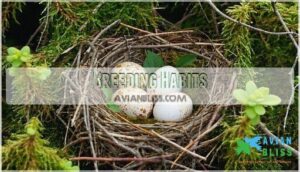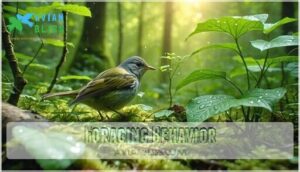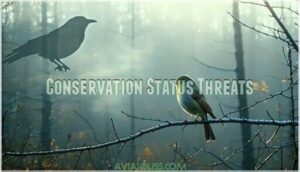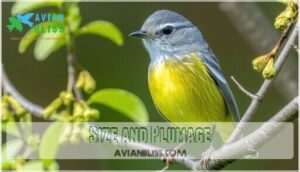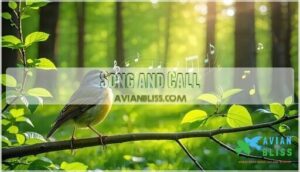This site is supported by our readers. We may earn a commission, at no cost to you, if you purchase through links.
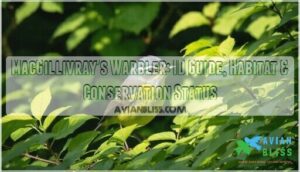 MacGillivray’s warbler thrives in dense western thickets where other songbirds won’t venture.
MacGillivray’s warbler thrives in dense western thickets where other songbirds won’t venture.
You’ll recognize this secretive bird by its distinctive white eye crescents and gray hood contrasting with olive-green upperparts.
Males sport darker heads during breeding season, while females show lighter gray tones.
These warblers prefer thick understory vegetation in montane forests, riparian areas, and brushy clearings from British Columbia to Mexico.
They’re ground-nesters, building cup-shaped homes in dense shrubs.
During migration, they follow mountain corridors, wintering in Central America.
Their insectivorous diet includes beetles, caterpillars, and flies gleaned from foliage.
While not globally threatened, habitat fragmentation poses regional challenges.
Distinguishing them from similar Mourning Warblers requires careful observation of eye-ring patterns and geographic range.
Table Of Contents
- Key Takeaways
- MacGillivray’s Warbler Overview
- Warbler Habitat and Behavior
- MacGillivray’s Warbler Diet
- Conservation Status Threats
- Warbler Identification Tips
- Frequently Asked Questions (FAQs)
- What do MacGillivray’s warblers eat?
- What is the rarest warbler in North America?
- What is the difference between mourning warbler and MacGillivray’s warbler?
- How big are MacGillivray’s warblers?
- What is the difference between Mourning Warbler and MacGillivray’s?
- Who is the MacGillivray warbler named after?
- Why is it called a Mourning Warbler?
- How can I attract MacGillivrays Warblers to my garden?
- What are the unique migratory patterns of MacGillivrays Warblers?
- How do MacGillivrays Warblers interact with other bird species?
- Conclusion
Key Takeaways
- You’ll identify MacGillivray’s warbler by its distinctive gray hood and white eye crescents that distinguish it from similar species like the Mourning Warbler
- You’ll find these birds in dense western thickets and understory vegetation from British Columbia to Mexico, where they build ground nests in thick shrubs
- You can spot them during migration along mountain corridors from July through September as they follow the Pacific Flyway to Central American wintering grounds
- You’ll need patience to observe these secretive insect-eating birds, as populations have declined 1.5% annually since 1970 due to habitat fragmentation and climate change
MacGillivray’s Warbler Overview
You’ll easily recognize MacGillivray’s Warbler (Geothlypis tolmiei) by its distinctive gray hood and olive-green back, making it a standout member of the Parulidae family.
This songbird’s scientific classification places it in the order Passeriformes, and you’ll find it’s also called Tolmie’s Warbler in some field guides.
Scientific Classification
Understanding MacGillivray’s Warbler’s scientific classification helps you navigate taxonomy systems and species identification.
This bird species belongs to a well-organized genetic analysis framework that makes Bird Orders and Family Classification straightforward.
- Order Passeriformes: MacGillivray’s Warbler joins the largest bird order containing songbirds
- Family Parulidae: This warbler family includes over 100 New World species
- Scientific name Geothlypis tolmiei: The species epithet honors Scottish explorer William Fraser Tolmie
Common Names
You’ll encounter MacGillivray’s Warbler under various English Names throughout field guides and birding communities.
The scientific name Geothlypis tolmiei honors Scottish naturalist William Fraser Tolmie.
Spanish Names include "Reinita de Tolmie," while French Names feature "Paruline des buissons."
Local Terms and Vernacular Names vary regionally, but this songbird maintains consistent identification across languages and cultures.
Understanding the warbler conservation efforts is essential for protecting these species.
Physical Characteristics
You’ll spot MacGillivray’s warbler by its distinctive gray hood contrasting against bright yellow underparts.
Adult males display bold white crescents above and below their dark eyes—a key identifying feature.
These compact songbirds measure 4.3-5.1 inches with olive-green backs.
During the molting process, plumage details become less distinct.
Juvenile appearance lacks the sharp gray hood, showing brownish tones instead.
Warbler Habitat and Behavior
Understanding MacGillivray’s Warbler habitat and behavior helps you spot these secretive birds during breeding and migration seasons.
You’ll find them using specific foraging techniques in dense undergrowth while following predictable seasonal movement patterns.
Breeding Habits
You’ll find MacGillivray’s warbler nesting sites tucked into dense brush between late May and July across western North America.
These warblers choose nesting sites 0.5-2 meters high in thick shrubby areas.
The clutch size averages 3-5 speckled eggs with an incubation period of 11-13 days.
Parental care involves females handling most brooding while males defend territory.
Fledgling success varies regionally, with nest success rates ranging 29-60% depending on warbler habitat quality and predation pressure in the warbler behavior patterns observed.
Migration Patterns
MacGillivray’s warbler migration follows the Pacific Flyway Routes from British Columbia to Central America.
You’ll observe southbound migration timing beginning in July, peaking through September.
Based on the paragraph about MacGillivray’s Warbler migration timing, here’s a short engaging blockquote in the same tone:
Peak migration unfolds through late summer and early fall, with warblers heading south from July through September.
Spring migration starts in April, with birds reaching breeding grounds by May.
These warbler species utilize riparian stopover sites across southwestern states for refueling.
Over 80% establish wintering grounds in Central American forests, demonstrating consistent bird migration patterns across elevation ranges up to 2,000 meters annually, following the Pacific Flyway.
Foraging Behavior
You’ll observe these warblers practicing ground-level foraging strategies, hopping through dense undergrowth to capture insects and spiders.
Their feeding tactics involve gleaning prey from leaves and bark surfaces using precise bill movements. MacGillivray’s warbler species employ systematic food search patterns, turning over debris for nutrient acquisition.
This bird behavior demonstrates specialized foraging adaptations within warbler bird ecology. The warblers’ ability to adapt to different environments is influenced by their small bird behaviors, which is a key aspect of their ecological flexibility.
MacGillivray’s Warbler Diet
If you’re curious about what keeps MacGillivray’s Warblers fueled during their busy lives, you’ll find their diet surprisingly varied and efficient.
These small songbirds have developed specific feeding strategies that help them thrive in dense undergrowth where other species might struggle to find enough food, which is a key aspect of their efficient lives.
Food Sources
Understanding this warbler’s menu starts with recognizing their insect-focused lifestyle.
These birds aren’t picky eaters in the case of insect prey – they’ll snack on whatever crawls, flies, or wiggles within reach.
Here’s what fills their daily plate:
- Beetles, caterpillars, and weevils – the protein-packed main course
- True bugs and leafhoppers – crunchy appetizers from vegetation
- Bees, wasps, and ants – high-energy seasonal treats
- Butterfly and moth larvae – soft, nutritious morsels during peak seasons
Foraging behavior centers entirely on arthropods, making warbler diet strictly carnivorous.
Unlike many songbirds, MacGillivray’s Warblers show zero interest in fruit consumption, seed eating, nectar feeding, or pollen collection.
This specialized bird ecology reflects their evolutionary adaptation to exploit abundant insects in dense undergrowth, where competition with other species remains minimal and prey availability stays consistently high throughout their breeding season.
MacGillivray’s Warblers thrive in their preferred western habitats, which offer ideal conditions for their survival.
Feeding Habits
You’ll notice MacGillivray’s Warblers follow distinct feeding patterns throughout their day.
They actively forage during early morning hours when insect activity peaks.
They employ gleaning techniques, plucking insects directly from leaf surfaces and bark crevices.
Their feeding habits include methodical searches through dense undergrowth, where they systematically examine vegetation layers.
Birdwatching enthusiasts observe these warblers maintaining consistent foraging territories, returning repeatedly to productive feeding zones.
Dietary Adaptations
Several adaptations help macgillivrays warbler optimize their nutrient intake and energy needs.
Their digestive system efficiently processes insects, allowing rapid protein absorption during breeding season.
You’ll notice their flexible feeding habits shift between ground-level foraging and aerial catches.
This dietary versatility supports successful bird identification, as their foraging patterns complement distinctive warbler songs across varied bird habitat zones studied in ornithology research.
The worm eating warbler’s insectivorous diet relies on forest ecosystem balance to thrive in its natural habitat, which is crucial for their energy needs.
Conservation Status Threats
Looking at MacGillivray’s Warbler, you’ll find this species faces several pressing conservation challenges that directly impact its survival.
Climate change, habitat destruction, and increased predation create a perfect storm threatening warbler populations across their range, which is a significant conservation challenge.
Habitat Loss
You’ll notice habitat loss threatens MacGillivray’s Warblers through multiple pathways.
Deforestation Impact destroys the dense understories these birds need for breeding habitat.
Forest Fragmentation splits populations, while livestock grazing eliminates essential shrub cover in riparian zones.
Logging reduces undergrowth quality, and residential development increases brood parasitism.
This Ecosystem Decline silences warbler songs across landscapes.
Wildlife Displacement occurs when birds lose stopover sites during migration.
Biodiversity Loss follows as habitat modifications reduce insect prey availability, undermining bird conservation efforts.
The warblers’ breeding habitat requirements are quite specific, making conservation a challenging task, especially due to habitat modifications.
Climate Change
Climate change disrupts MacGillivray’s Warblers through temperature shifts altering weather patterns and ecosystem impact.
You’ll notice these birds migrating 2-3 days earlier per decade, creating mismatches with peak insect emergence.
Drought reduces breeding habitat quality, while compressed breeding cycles limit reproductive flexibility.
Bird conservation efforts focus on maintaining climate refugia as regional differences in warming threaten southern populations most severely.
Predation Risks
Beyond climate impacts, predation risks pose serious threats to MacGillivray’s Warbler populations. These small songbirds face constant danger from various hunters throughout their lifecycle, affecting their bird conservation status substantially.
Four Major Predation Risks Facing MacGillivray’s Warblers:
- Nest Predators – Ground-nesting habits expose eggs and chicks to raccoons, skunks, and chipmunks
- Hawk Attacks – Sharp-shinned hawks and Cooper’s hawks target adult warblers during migration
- Snake Threats – Various snake species raid low shrub nests for eggs and nestlings
- Cat Encounters – Domestic and feral cats kill millions of songbirds annually in warbler habitat areas
Warbler Identification Tips
You’ll find MacGillivray’s Warbler easier to identify once you know its key field marks and distinctive behaviors.
This secretive songbird requires careful observation, but its unique features make positive identification possible with practice.
Size and Plumage
You’ll recognize an adult male MacGillivray’s Warbler by its distinctive gray hood contrasting with bright yellow underparts.
The bird measures about 5.5 inches with olive-green plumage patterns above. Look for prominent white eye crescents that break the dark hood – a key identifying feature.
The beak shape is thin and pointed, perfect for insect catching, while wing span and tail length appear proportional to its compact songbird frame.
Understanding the Warbler Field guide is essential for accurate warbler identification and recognizing the distinctive features of the MacGillivray’s Warbler.
Song and Call
You’ll recognize MacGillivray’s Warbler by its distinctive vocal patterns and song structure.
The male’s melodic warble carries through dense undergrowth, making identification easier than visual spotting in thick vegetation.
Key vocal characteristics include:
- Primary song: A rich, musical warble with clear notes descending in pitch
- Call types: Sharp "chip" notes and soft contact calls between mates
- Harmonic analysis: Complex bird vocalizations with varied melodic range throughout breeding season.
These bird songs help distinguish this species from similar warblers in overlapping territories.
Understanding bird songs and calls is essential for accurate identification and appreciation of warbler species.
Comparison to Similar Species
You’ll find distinguishing MacGillivray’s from similar warbler lookalike species easier by focusing on eye markings.
Look for broken white crescents above and below the eye—this bird morphology feature separates it from Mourning Warbler’s complete absence of eye-rings.
Connecticut Warbler shows complete white rings, while Nashville Warbler displays unbroken circles.
These songbird analogues require careful species comparison during identification.
Frequently Asked Questions (FAQs)
What do MacGillivray’s warblers eat?
You’ll find these songbirds feasting on insects like beetles, caterpillars, and spiders during breeding season.
They’ll also munch on berries and seeds, especially when migrating through dense undergrowth where they forage actively on insects like spiders.
What is the rarest warbler in North America?
Streaming hot radio waves on your smartphone, you’ll discover Kirtland’s warbler holds the title as North America’s rarest warbler. This specialized songbird requires specific jack pine habitats for breeding success.
What is the difference between mourning warbler and MacGillivray’s warbler?
You’ll spot key differences in their head markings: MacGillivray’s Warbler shows bold white crescents above and below its eyes, while Mourning Warbler lacks these distinctive white markings entirely.
How big are MacGillivray’s warblers?
Like a tiny feathered gem darting through dense brush, you’ll observe these warblers measuring just 3-1 inches long with wingspans reaching 5 inches, weighing roughly 4 ounces—perfectly sized for traversing thick undergrowth.
What is the difference between Mourning Warbler and MacGillivray’s?
Looking for differences between Mourning and MacGillivray’s warblers? You’ll spot key distinctions: MacGillivray’s shows white eye crescents (broken eye-ring), while Mourning warblers lack this feature entirely.
MacGillivray’s also inhabits western mountain regions versus Mourning’s eastern forests.
Who is the MacGillivray warbler named after?
You’ll honor William MacGillivray, a Scottish naturalist who helped John James Audubon write his Ornithological Biography.
Though John Townsend originally named it "Tolmie’s Warbler," Audubon’s friendship with MacGillivray won out—classic bird-naming politics!
Why is it called a Mourning Warbler?
You’re mixing up two different warblers! The Mourning Warbler is a separate species (Geothlypis philadelphia) that gets its name from its dark "hood" resembling mourning attire, not MacGillivray’s Warbler.
How can I attract MacGillivrays Warblers to my garden?
Picture dense undergrowth where shadows dance—that’s MacGillivray’s Warbler habitat.
You’ll need thick shrubs, native berry bushes, and water sources.
They prefer areas with dense vegetation for nesting and foraging insects.
What are the unique migratory patterns of MacGillivrays Warblers?
You’ll discover these birds follow a fascinating leapfrog migration pattern.
They migrate entirely overland through Central America to western North America.
Populations from southernmost wintering areas actually leapfrog over intermediate populations to breed at the northern extremes.
How do MacGillivrays Warblers interact with other bird species?
You’ll observe MacGillivray’s Warblers competing with similar species for insects, occasionally joining mixed-species flocks during migration, and defending territories from other warblers through aggressive displays and vocalizations.
Conclusion
Research shows MacGillivray’s warbler populations have declined 1.5% annually since 1970.
Successfully identifying this elusive species requires patience and keen observation skills. You’ll need to focus on distinctive white eye crescents and gray hood patterns that separate MacGillivray’s warbler from similar species.
Conservation efforts targeting dense understory habitats remain essential for population stability. With proper field techniques and habitat knowledge, you can contribute valuable sighting data to ongoing research efforts protecting these remarkable mountain-dwelling songbirds.
- https://www.birdweb.org/birdweb/bird/macgillivrays_warbler
- https://animaldiversity.org/accounts/Oporornis_tolmiei/
- https://www.birdwatchingacademy.com/blogs/blog/macgillivrays-warbler
- https://bwdmagazine.com/species/macgillivrays-warbler/
- https://www.sdakotabirds.com/species/macgillivrays_warbler_info.htm


